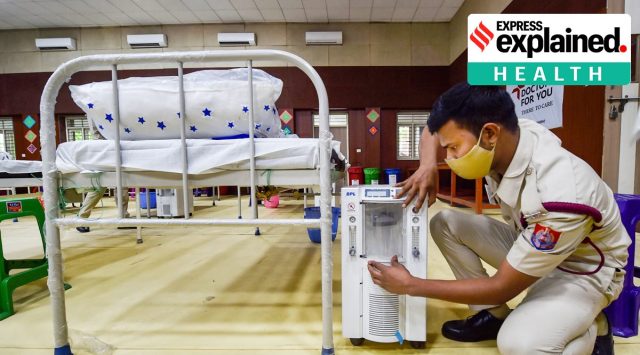Oxygen concentrators: Why they are in demand, how they differ from oxygen cylinders
An oxygen concentrator is a medical device that concentrates oxygen from ambient air. Atmospheric air has about 78 per cent nitrogen and 21 per cent oxygen, with other gases making up the remaining 1 per cent.
 A volunteer prepares beds with oxygen concentrators at a Covid Care Centre inside Sarvodaya Bal Vidyalaya, as coronavirus cases surge in New Delhi, Tuesday, April 20, 2021. (PTI Photo/Manvender Vashist)
A volunteer prepares beds with oxygen concentrators at a Covid Care Centre inside Sarvodaya Bal Vidyalaya, as coronavirus cases surge in New Delhi, Tuesday, April 20, 2021. (PTI Photo/Manvender Vashist)It’s only a little bigger than a computer monitor, yet as cases surge and with oxygen cylinders in short supply across several states, the concentrator is among the most sought after devices for oxygen therapy, especially among patients in home isolation and for hospitals running out of oxygen.
Newsletter | Click to get the day’s best explainers in your inbox
How does it work?
An oxygen concentrator is a medical device that concentrates oxygen from ambient air. Atmospheric air has about 78 per cent nitrogen and 21 per cent oxygen, with other gases making up the remaining 1 per cent. The oxygen concentrator takes in this air, filters it through a sieve, releases the nitrogen back into the air, and works on the remaining oxygen.
This oxygen, compressed and dispensed through a cannula, is 90-95 per cent pure. A pressure valve in concentrators helps regulate supply, ranging from 1-10 litres per minute.
According to a 2015 report by the WHO, concentrators are designed for continuous operation and can produce oxygen 24 hours a day, 7 days a week, for up to 5 years or more.
At 90-95 per cent purity, is the oxygen from concentrators pure enough?
While it is not as pure as LMO (99%), experts say it is good enough for mild and moderate Covid-19 patients with oxygen saturation levels of 85% or above. It is, however, not advisable for ICU patients.
Concentrators can be attached with multiple tubes to serve two patients at the same time, but experts don’t recommend it since it carries risk of cross-infection.
How are concentrators different from oxygen cylinders and LMO?
Oxygen concentrators are the easiest alternatives to cylinders but can only supply 5-10 litres of oxygen per minute (critical patients may need 40-50 litres per minute) and are best suited for moderately ill patients.
Concentrators are portable and unlike LMO that needs to be stored and transported in cryogenic tankers, need no special temperature. And unlike cylinders that require refilling, concentrators only need a power source to draw in ambient air.
How do they compare with cylinders in terms of cost and maintenance?
While at Rs 40,000-90,000 concentrators are more expensive than cylinders (Rs 8,000-20,000), it’s largely a one-time investment. Apart from electricity and routine maintenance, there’s little by way of operational cost, unlike cylinders that involve refilling costs and transportation.
The market
Industry experts say the demand of oxygen concentrators has gone up from 40,000 annually to 30,000-40,000 a month. Dr Rajiv Nath, forum coordinator of AIMED, an association of the medical device industry, estimates a daily demand of 1,000-2000 concentrators, but says there are not enough manufacturers to meet that kind of demand.
It’s a largely import market, with Philips and Longfian Scitech among the big players.
- 01
- 02
- 03
- 04
- 05






































